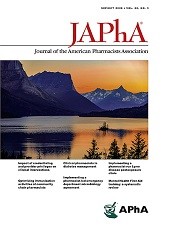Karen B. Farris, Daniel Ashwood, Jennifer McIntosh, Natalie A. DiPietro, Nicole Monastersky Maderas, Sharon Cohen Landau, John Swegle, Orod Solemani

Abstract
Objectives: To review the literature regarding pharmacists’ roles in preventing unintended pregnancy, review the relevant laws and policies in the United States to describe pharmacists’ and/or pharmacy’s role in policy development related to unintended pregnancy, and identify partners who pharmacists can work with in this public health area.
Data sources: A systematic review was conducted focusing on the role of pharmacists in unintended pregnancy. For practice, articles were identified in Medline through July 1, 2009, using MeSH and keywords. For policy, two authors examined the current status of access issues related to over-the-counter (OTC) status and collaborative practice agreements. Partners were identified in the reviews and authors’ experiences.
Data extraction: English-language, U.S.-based articles that contained either qualitative or quantitative data or were review articles addressing pharmacist interventions, pharmacists’ knowledge and attitudes regarding contraception, and pharmacists’ comfort and ability to counsel on preventing unintended pregnancy were included.
Data synthesis: Some improvements to emergency contraception (EC) access in pharmacies have occurred during the previous decade. Studies focused on counseling, pharmacist provision of depot reinjection, and pharmacist initiation of oral contraceptives were positive. No studies linked increased contraceptive access in pharmacies to lower pregnancy rates. In terms of policy, the literature described three access-related areas, including (1) EC and conscience clauses, (2) collaborative practice agreements, and (3) changes in prescription to OTC status. Pharmacists’ partnerships may include physicians/clinicians, local health departments, family planning organizations, nongovernmental organizations, and colleges of pharmacy.
Conclusion: Currently, pharmacists may increase access to contraceptives primarily via EC and use of collaborative practice agreements to initiate and/or continue hormonal contraceptives. New practice models should be implemented in community or clinic practices as allowed by collaborative practice regulations in each state. We encourage researchers and practitioners to consider a community approach in their endeavors by working with numerous types of primary care providers and organizations to explore ways to increase contraceptive access.
Farris KB, Ashwood D, McIntosh J, DiPietro NA, Maderas NM, Landau SC, Swegle J, Solemani O. Preventing unintended pregnancy: pharmacists’ roles in practice and policy via partnerships. J Am Pharm Assoc (2003). 2010 Sep-Oct;50(5):604-12. Review.